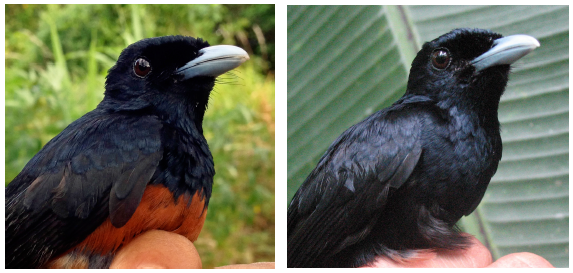Dark plumage helps birds survive on small islands

Animal populations on islands tend to develop weird traits over time, becoming big (like Galapagos tortoises) or small (like extinct dwarf elephants) or losing the ability to fly (like the flightless parrots of New Zealand).
One less-studied pattern of evolution on islands is the tendency for animal populations to develop "melanism"—that is, dark or black coloration. J. Albert Uy and Luis Vargas-Castro of the University of Miami found an ideal species to study this phenomenon in the Chestnut-bellied Monarch (Monarcha castaneiventris), a bird found in the Solomon Islands. Most have the chestnut belly suggested by their name, but in the subspecies found in the Russell Islands, a few all-black birds coexist with the chestnut-bellied majority. After visiting 13 islands of varying sizes to survey their Chestnut-bellied Monarch populations, Uy and Vargas-Castro confirm in a new paper published this week in The Auk: Ornithological Advances that island size predicts the frequency of melanic birds, with populations on smaller islands including more dark individuals.
Because the pattern is repeated on island after island, it is very unlikely to have developed through random chance; instead, dark coloration must provide some sort of benefit to birds on small islands. Studies in mammals and fish have found a genetic link between melanism and aggressive behavior, and Uy and Vargas-Castro speculate that the limited space available on smaller islands makes competition for breeding territories more intense, giving an advantage to the most aggressive individuals. Previous experiments with other Monarcha castaneiventris subspecies using taxidermied birds and recorded songs have shown that melanic birds react more aggressively than their chestnut-bellied counterparts when they perceive a threat to their territory.
Uy had been fascinated by Chestnut-bellied Monarchs ever since reading a description of their plumage variations in Ernst Mayr's seminal book on speciation, Systematics and the Origin of Species from a Viewpoint of a Zoologist, when he was a graduate student. "I was hooked and longed to work on the group," he says. "I thought this would be the perfect species to explore these questions about the ecology of plumage diversification and the origin of species, as the variable populations of the chestnut-bellied flycatcher may be at different stages of the speciation process. It took me over a decade to finally manage to get to the Solomons, and I've been working on these flycatchers now for nearly 10 years."
"Patterns of biodiversity on islands have always been important for understanding fundamental principals in ecology and evolution. Using the same archipelago that enchanted Ernst Mayr decades ago, Uy and Vargas-Castro reveal fascinating patterns of melanism and island size," adds Rebecca Safran of the University of Colorado, an expert on divergence between bird populations who was not involved in the study. "These patterns add to the fundamental importance of islands as natural experiments for studies in biodiversity."
More information: The Auk: October 2015, Vol. 132, No. 4, pp. 787-794. DOI: 10.1642/AUK-14-284.1
Provided by Central Ornithology Publication Office



















